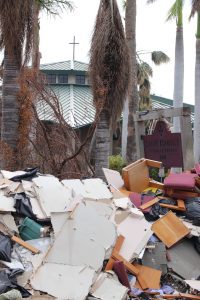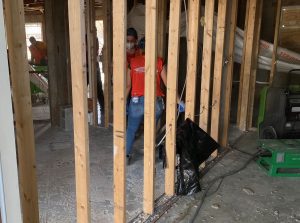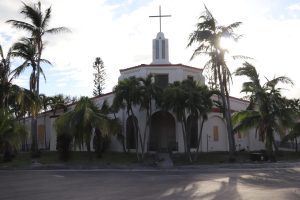In the two months since the devastating winds and waters of Hurricane Ian struck the Diocese of Venice the monumental work to clean up and rebuild have been going strong.
 Ian struck on Sept. 28, 2022, with winds up to 155 mph and storm surge measured at 15 feet swept across Sanibel and Fort Myers Beach. In all, the wide impacts of Ian caused damage at 30 Parishes and 10 Catholic schools, as well as at many other Diocesan properties.
Ian struck on Sept. 28, 2022, with winds up to 155 mph and storm surge measured at 15 feet swept across Sanibel and Fort Myers Beach. In all, the wide impacts of Ian caused damage at 30 Parishes and 10 Catholic schools, as well as at many other Diocesan properties.
Two of the most dramatic impacts in the Diocese were to St. Isabel Parish on Sanibel, as well as to Ascension Parish and the Poor Clare Monastery of San Damiano on Fort Myers Beach.
At St. Isabel, the Parish church and hall suffered severe storm surge damage and contractors hired by the Diocese have worked non-stop to mitigate against further damage since Oct. 25, the first day access was granted to the island for contractors after the causeway was rebuilt.
A visit to the Parish on Nov. 12 revealed a team of 30 contractors chiseling out the tile floor and cutting out moldy drywall in the church after already doing identical work in the neighboring hall.
 The approach to the Parish on Sanibel-Captiva Road revealed a pile of debris at least six feet high and approximately 75 yards long, obstructing the street view of the Parish property. This pile of debris included the contents of the hall and church, including flooring, drywall, ceiling tiles, furniture, and other built-in materials which were all beyond salvage. In addition, there was the debris that was scattered across the property by the surge and wind, such as trees, branches, pieces ripped from the Parish buildings, as well as various detritus scattered by the wind and water from nearby properties.
The approach to the Parish on Sanibel-Captiva Road revealed a pile of debris at least six feet high and approximately 75 yards long, obstructing the street view of the Parish property. This pile of debris included the contents of the hall and church, including flooring, drywall, ceiling tiles, furniture, and other built-in materials which were all beyond salvage. In addition, there was the debris that was scattered across the property by the surge and wind, such as trees, branches, pieces ripped from the Parish buildings, as well as various detritus scattered by the wind and water from nearby properties.
One of the lead contractors on Sanibel said the damage was severe but could have been worse as the walls of the church and hall both withstood the force of the wind and rain. The roofs of both buildings held up well, although there was water intrusion through the soffits and impacts to the roof. The drying of the building interiors was completed by mid-November, with clearing out the remaining debris from the grounds, the final step yet to be completed.
A message to parishioners on Nov. 18 stated “The first steps have begun toward the restoration of our Parish… Each building faces substantial restoration.”
 The cleanup at Ascension Parish and the Poor Clare monastery on Fort Myers Beach started sooner but the destruction there was more complete. Contractors have been on the property since two weeks after Ian’s landfall dealing with what was left over after the storm surge blasted through the church, hall, rectory, and monastery.
The cleanup at Ascension Parish and the Poor Clare monastery on Fort Myers Beach started sooner but the destruction there was more complete. Contractors have been on the property since two weeks after Ian’s landfall dealing with what was left over after the storm surge blasted through the church, hall, rectory, and monastery.
By Nov. 12, all of the main debris, including the contents of all the buildings, had been pushed to the curb. The first part of this monumental task was clearing access to the property as there was rubble from at least nine destroyed homes piled as high as 15 feet. The debris was so deep that crews used front-end loaders and bulldozers to do the heavy work. The result was that most of the vegetation was scraped away, leaving bare dirt and sand in most areas. The final part of this process was draining and clearing out two large ponds which were overflowing with various wreckage.
 In each building, the work crews also cut out the drywall and floors. Fortunately, the walls of the church and monastery were made of concrete, meaning no structural damage occurred. Part of securing the property from any further damage included putting plywood over each of the blown-out windows and doors as air blowers were helping with the final drying out process.
In each building, the work crews also cut out the drywall and floors. Fortunately, the walls of the church and monastery were made of concrete, meaning no structural damage occurred. Part of securing the property from any further damage included putting plywood over each of the blown-out windows and doors as air blowers were helping with the final drying out process.
A sign of hope on the property was that the larger trees survived, and the stripped leaves are slowly returning.
Before reconstruction can begin on Sanibel and Fort Myers Beach, additional contractors and supplies need to be accumulated and brought to the barrier islands.
Joe Rego, Diocesan Buildings Director, who is overseeing the response to Hurricane Ian, explained that the Diocese is actively working to hire contractors to repair damage to all properties, but that the extensive damage at St. Isabel and on Fort Myers Beach will require an unknown amount of time to complete. This is because the mechanical, electrical and plumbing systems in each building need to be assessed and either completely replaced or require extensive repairs after being exposed to storm surge inundation of salt water.
 While it is hoped that reconstruction work can begin immediately, there is a shortage of workers and key supplies, such as drywall, plywood, flooring, and roofing materials, throughout the disaster zone.
While it is hoped that reconstruction work can begin immediately, there is a shortage of workers and key supplies, such as drywall, plywood, flooring, and roofing materials, throughout the disaster zone.
“These issues are not unique to the barrier island properties, this is across the region,” Rego explained. “That part of the rebuilding effort is out of our control. The contractors have been up front in explaining the challenges and will expedite work wherever possible.”
All options are on the table, Rego added, meaning work at St. Isabel and on Fort Myers Beach might be done in phases to ensure some buildings are operational faster than others versus doing everything all at once.
“This is going to be a long process and we know we are not alone in facing these challenges,” he said. “We ask everyone’s patience as we work our way through this complicated process. In the end, we will build back better; it just might take a while.”
If you would like to support the Diocese of Venice efforts to recover from Hurricane Ian, please visit https://dioceseofvenice.org/hurricaneian/.





